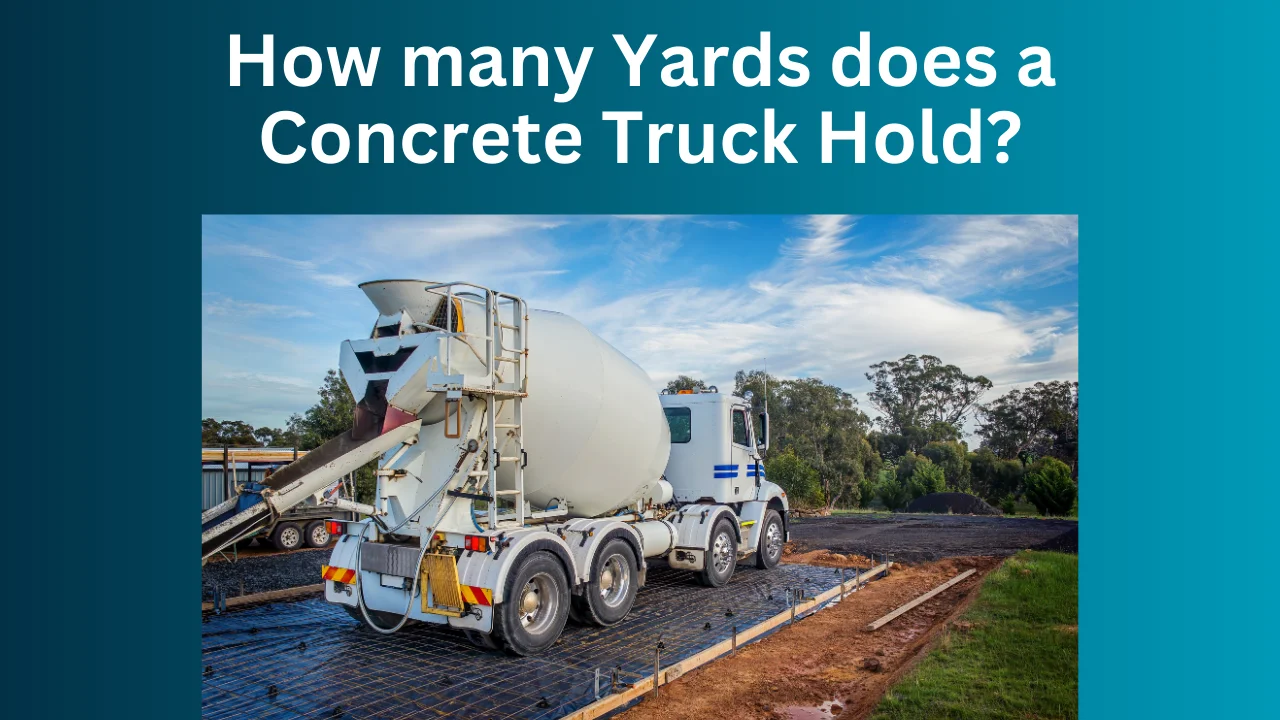An important thing to keep in mind when asking “how many yards does a concrete truck hold?” is that different models and designs of concrete trucks (also called cement mixers or concrete mixer trucks) have vastly different capacities. Usually, these trucks can transport concrete with a capacity of 8 to 12 cubic yards. For residential and smaller-scale commercial projects, smaller trucks with a capacity of about 8 cubic yards are perfect. However, for larger-scale building projects, the larger trucks are more than enough, as they can transport concrete up to 12 cubic yards. For an area that is 8 feet by 10 feet and 4 inches deep, one cubic yard of concrete is more than enough. Because it impacts the total efficiency of the concrete delivery and the amount of trips needed, the capacity of these trucks is vital for construction project planning. To keep construction schedules on track and budgets in check, knowing the truck’s capacity is essential for project cost and time estimates.
Essential Features of Concrete Trucks
Capacity Variations and Project Planning
A concrete truck’s capacity is more than a mere numerical value; it is an integral aspect that impacts the entirety of the building process. The amount of deliveries required for a project can be better estimated, for instance, if one is aware that a truck can hold 8, 10, or 12 cubic yards of concrete. The project’s schedule, budget, and manpower needs are all affected by this computation. With a larger truck, fewer trips are needed, which could mean less time and money spent on concrete delivery.
Understanding Concrete Truck Load Sizes
The standard unit for quantifying concrete volume is cubic yards, which is commonly used to determine the load size of a concrete truck. In order to calculate the exact amount of concrete required for individual project sections, this measurement is critical for project managers and contractors. By having a good grasp of the load size, experts can steer clear of ordering too much or too little concrete, preventing costly delays.
Efficiency in Concrete Delivery
When building anything, speedy delivery of concrete is of the utmost importance. A truck’s yard capacity is a direct indicator of how fast a site can receive the concrete it needs. By reducing the number of deliveries required, larger trucks can make the site run more smoothly and with less interruption. Sites with restricted access or lower concrete requirements may be better served by smaller trucks, which would ensure more prudent use of resources.
Impact on Construction Timelines
Timeliness of construction is greatly impacted by the capacity of concrete trucks. The construction process can be expedited with larger capacities, which allow for the delivery of large volumes of concrete in fewer trips. When dealing with large-scale projects, this is of the utmost importance because delays can result in substantial financial penalties and logistical difficulties.
Optimal Use of Concrete Trucks in Different Projects
The amount of concrete needed for a particular construction project dictates the truck capacity that is most appropriate. Due to space constraints and lower concrete needs, smaller trucks may be more suitable for residential projects, whereas larger trucks are typically necessary for commercial and industrial projects to efficiently handle higher volume requirements.
Right Concrete Truck for Your Project
Residential vs. Commercial Truck Capacities
The size of the project is the primary factor to consider when selecting a concrete truck. There is usually less concrete involved in residential projects, so smaller trucks are usually necessary. Because of their reduced size, these trucks are better able to deliver concrete to tight spaces and navigate residential neighborhoods with ease. Larger trucks, on the other hand, can transport more concrete on a single trip, which streamlines commercial projects by reducing the total number of deliveries.
Factors Influencing Concrete Truck Capacity
The design of the truck, the mixer used, and the regulations controlling vehicle size and weight on roads are some of the factors that affect the capacity of a concrete truck. Having a good grasp of these factors is crucial for choosing the appropriate truck for your project requirements and staying in line with transportation regulations in your area.
Efficiency with Proper Truck Selection
Accuracy and reducing waste are just as important as speed when it comes to construction efficiency. Make sure you don’t run out of concrete by selecting a truck with the right capacity for your project. Better management of resources and cost savings are the results of such meticulous planning.
Planning Construction Projects Based on Truck Yardage
To have a successful construction, precise planning is essential. To make sure that every step of the construction process runs smoothly and on time, project managers base their plans on the yardage that concrete trucks are capable of carrying. This allows them to schedule deliveries and work phases more effectively.
Variations in Concrete Truck Yardage
Differences Between Small and Large Trucks
Concrete trucks come in a broad range of sizes, from those used for smaller, more precise jobs to those used for larger, more widespread commercial or industrial jobs. Trucks with a capacity of around 8 cubic yards are perfect for landscaping or residential driveways because they are easier to manoeuvre in confined areas. Projects requiring large volumes of concrete quickly, such as those involving building foundations or large pavements, are best served by larger trucks with a capacity of up to 12 cubic yards.
Technological Advances in Concrete Trucks
Concrete trucks have come a long way in recent years, with improved designs that allow for more payload while still being safe and easy to maneuver. You can load more concrete onto the vehicle without sacrificing performance thanks to features like an improved drum design, optimized chassis configurations, and material flow management. Both the carrying capacity and the time needed for loading and unloading are improved by these technological advancements, which further streamlines project timelines.
Impact on Project Cost and Efficiency
A project’s cost-effectiveness is directly affected by the yardage that a concrete truck can carry. Trucks with more capacity cut down on unnecessary trips, which in turn reduces transportation costs and has less of an effect on the environment. Reducing labor costs and the carbon footprint associated with multiple deliveries is essential for large-scale projects to stay on budget and meet schedule.
Optimal Strategies for Concrete Delivery
Selecting the Right Truck for Different Terrain
The selection of a concrete truck is heavily influenced by the nature of the project’s terrain. Trucks with superior suspension and driving capabilities are essential for projects located in hilly or uneven terrain, as they ensure the safe delivery of concrete. Tight corners and narrow streets may necessitate smaller, more nimble trucks for urban projects.
Balancing Load Size with Accessibility
The accessibility of the project site must be carefully considered alongside the requirement for large quantities of concrete. It may be more practical to use a number of smaller trucks rather than a handful of larger ones for sites that are difficult to reach. This approach guarantees that trucks can reach the pour site without any problems and that the delivery process stays seamless.
Scheduling for Maximum Efficiency
Making the most of concrete truck capacities requires efficient scheduling. Project managers can stop delays and make sure fresh concrete is available when needed by timing the arrival of trucks to match the pace of construction. Both the building crew and the concrete supplier need to be in the know in order for this coordination to work.
Frequently Asked Questions
What is the Standard Capacity of a Concrete Mixer Truck?
The standard capacity of a concrete mixer truck ranges between 8 and 12 cubic yards. This range allows for flexibility in meeting the varying needs of different construction projects, from small residential repairs to large commercial developments.
How Many Cubic Yards Can a Cement Truck Carry?
While the typical range is 8 to 12 cubic yards, some specialized trucks can carry slightly more or less, depending on their design and the specific requirements of the projects they serve.
How to Calculate the Number of Concrete Truck Loads Needed for a Project?
To calculate the number of truckloads needed, divide the total cubic yards of concrete required for the project by the capacity of the truck. This simple calculation helps in planning and scheduling concrete deliveries efficiently.
What Factors Influence the Capacity of Concrete Trucks?
Factors include the design of the truck, local transportation regulations, and the specific requirements of the construction project. Each of these factors must be considered to ensure the right truck is used for each job.
How Does Truck Capacity Impact Construction Timelines?
The capacity of the trucks used can significantly speed up or slow down a project. Larger trucks mean fewer deliveries and faster completion of large-scale projects, while smaller trucks can be more suitable for detailed or smaller-scale tasks.
Conclusion
In order to optimize construction processes, reduce costs, and ensure timely project completion, it is essential to understand the capacities and capabilities of concrete trucks. Construction workers can improve productivity and quality by taking project size, terrain, and other variables into account when choosing a truck. Any construction project’s success is heavily dependent on factors such as strategic delivery, technological advancements, and variations in truck yardage. How many yards does a concrete truck hold? This crucial question can significantly impact planning and logistics, influencing the efficiency and effectiveness of concrete delivery on-site.

Shannon Reyes is a seasoned writer with a knack for crafting engaging blogs on a variety of service industries, including plumbing, cleansing, moving, pest control, and roofing. With a keen eye for detail and a passion for helping readers navigate complex topics, Shannon brings her expertise to life through informative and accessible content.












Thank you for your sharing. I am worried that I lack creative ideas. It is your article that makes me full of hope. Thank you. But, I have a question, can you help me?
Thank you for your sharing. I am worried that I lack creative ideas. It is your article that makes me full of hope. Thank you. But, I have a question, can you help me? https://accounts.binance.info/zh-CN/register-person?ref=WFZUU6SI